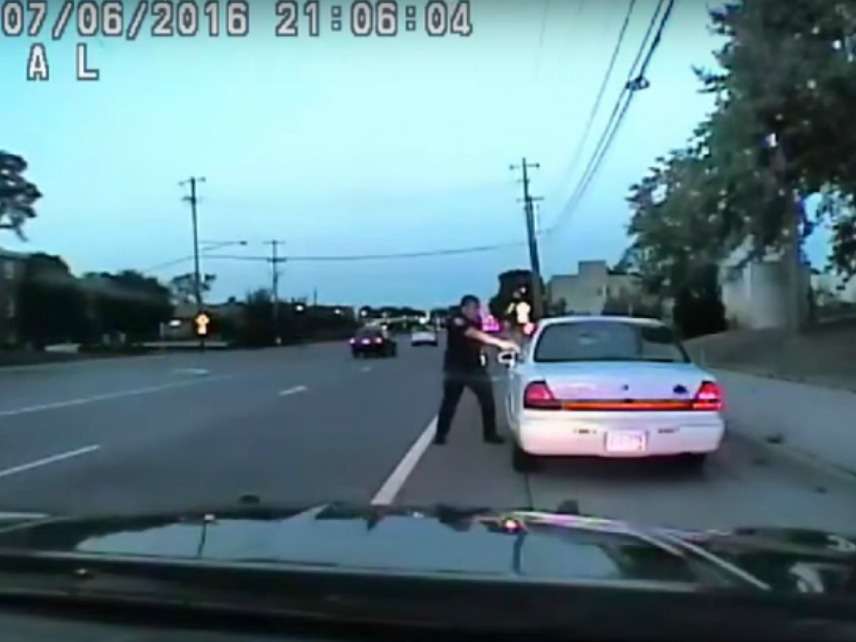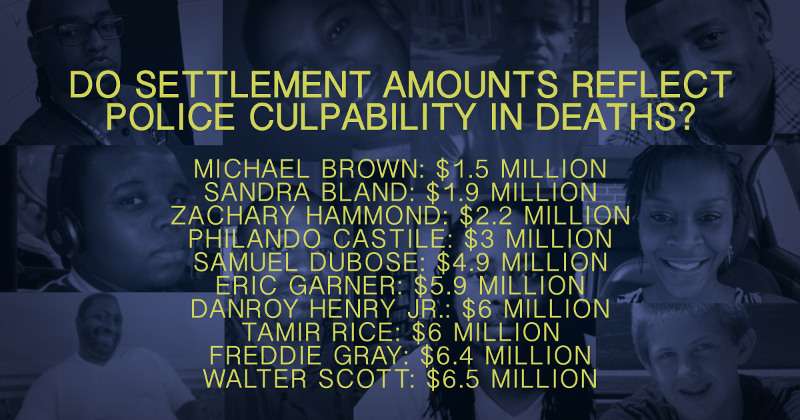Philando Castile's Mother to Get $3 Million From City That Hired Cop Who Killed Him
Do settlement amounts reflect police culpability in deaths?


The mother of Philando Castile, who was shot dead by St. Anthony, Minnesota, police officer Jeronimo Yanez last summer, will receive $3 million under a settlement agreement announced yesterday. The settlement, which will be covered by the city's liability insurance, avoids a federal civil rights lawsuit that Valerie Castile had planned to bring. Here is how the payment compares to settlements in other recent cases where people died at the hands of police or after being arrested:
Michael Brown: $1.5 million
Sandra Bland: $1.9 million
Zachary Hammond: $2.2 million
Philando Castile: $3 million
Samuel DuBose: $4.9 million
Eric Garner: $5.9 million
Danroy Henry Jr.: $6 million
Tamir Rice: $6 million
Freddie Gray: $6.4 million
Walter Scott: $6.5 million
The variation in payments is not a perfect indicator of police culpability (real or perceived) by any means, but there does seem to be a rough correspondence.
The 2014 death of Michael Brown, an 18-year-old black man, was one of the main motivating events behind the Black Lives Matter movement. But no state or federal charges were filed against Darren Wilson, the Ferguson, Missouri, officer who shot Brown, and a Justice Department investigation concluded that Wilson's self-defense claim was credible.
Sandra Bland, a 28-year-old black woman, died in jail, apparently by her own hand. But she would not have been in jail if Texas State Trooper Brian Encinia hadn't senselessly escalated a 2015 traffic stop for changing lanes without signaling. Encinia was fired and charged with falsifying his report on the incident.
Zachary Hammond, a 19-year-old white man, was shot and killed in 2015 by Lt. Mark Tiller of the Seneca, South Carolina, police department. No charges were filed against Tiller, who claimed (not very credibly) to fear that Hammond was about to run him over as he sped away from a penny-ante drug sting aimed at his date.
Although Yanez claimed Castile, a 32-year-old black man, was drawing a gun on him during a traffic stop for a nonfunctional brake light, all the evidence (aside from Yanez's testimony) suggested that Castile, who had calmly informed Yanez that he had a concealed weapon (for which he had a permit), was actually trying to retrieve his driver's license from his wallet. A state jury acquitted Yanez of second-degree manslaughter on June 16.
Samuel DuBose was shot to death in 2015 by University of Cincinnati police officer Ray Tensing after he started his car during a traffic stop based on a missing front license plate. Although Tensing claimed he was being dragged by the car, bodycam footage indicated otherwise. An indictment for murder and voluntary manslaughter was followed by two mistrials, both due to deadlocked juries.
Eric Garner died in 2014 after he was tackled by New York City police who were arresting him for selling untaxed cigarettes. One officer, Daniel Pantaleo, used what looked like an unauthorized chokehold on Garner, who repeatedly complained that he could not breathe. A local grand jury declined to indict Pantaleo.

Tamir Rice, a 12-year-old black boy, was shot and killed in 2014 by Cleveland police officer Timothy Loehmann, who mistook his Airsoft pellet pistol for a real firearm. A local grand jury declined to indict Loehmann or his partner, Frank Garmback, although Loehmann was fired for failing to disclose that he had been dismissed from a previous police position because of emotional instability.
Danroy Henry Jr., a 20-year-old black college student and football player, was shot and killed in 2010 by Pleasantville, New York, police officer Aaron Hess, who for reasons that are unclear stepped into the path of a car that Henry was driving and then treated him as a deadly threat. Hess did not face state or federal charges, although a Justice Department investigation concluded that Henry probably had his foot on the brake when his car hit Hess.
Freddie Gray, a 25-year-old black man, died in 2015 from a neck injury he suffered after being arrested by Baltimore police for possessing an allegedly illegal knife. Six officers faced state charges in connection with his death. One case ended in a mistrial and three officers were acquitted, after which the charges against the remaining two officers were dropped.
Walter Scott, a 50-year-old black man, was shot in the back by North Charleston, South Carolina, police officer Michael Slager while fleeing a 2015 traffic stop based on a nonfunctioning brake light. Slager was immediately dismissed. After a state jury failed to reach a verdict, Slager pleaded guilty to federal civil rights charges.
Except for the deaths of Michael Brown and Danroy Henry, all of these incidents were at least partly captured by some sort of camera. It makes sense that the largest settlement came in the Walter Scott case, where a damning bystander video showed that the officer was clearly not in danger at the time of the shooting. The facts were so unfavorable to Slager that he eventually pleaded guilty, making this the only case on the list to produce a conviction. It likewise makes sense that the smallest settlement was related to the death of Michael Brown, who scuffled with Wilson and seemed to pose a real threat.
Generally speaking, stronger self-defense claims seem to be associated with lower settlements. They also make criminal charges less likely, which in turn may play a role in settlement negotiations. The Danroy Henry settlement seems like an outlier, since Hess was indisputably in danger at the moment of the shooting, albeit a danger that he himself created. Like Tiller, who killed Zachary Hammond, Hess put himself in the path of a moving car.



Show Comments (52)